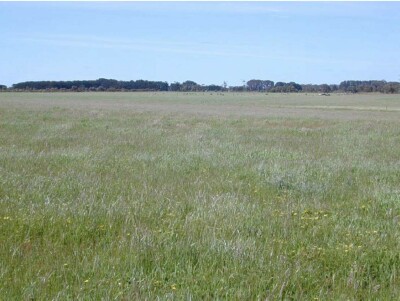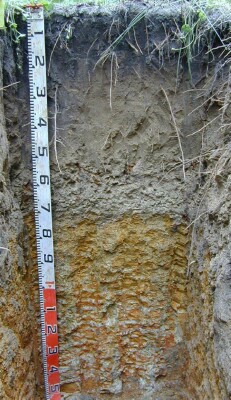WAS98 (Plot 2)
| Site: Was98 (Plot 2) | Land Unit: Byaduk basalts |
| Aust. Soil Class.: | |
 | General Land Unit Description: This land unit is a complex unit of steep slopes leading to drainage lines and gently undulating plains leading to the slopes, south east of Branxholme. The soils on the slopes leading to the drainage lines tend to be shallower than those on the plains. The soils on the plains commonly have a sandy topsoil with a bleached A2 horizon over a clay subsoil. A co-dominant soil type is a soil type lacking the sandy topsoil and tends to have a gradual increase in clay (Dermosol) similar to this site. These soils are intermixed with Sodosols. Two year old Eucalyptus globulus plantation on ex-agricultural land |
Site Description:
| Geology: Quaternary basalt | Internal drainage: Imperfectly drained |
| A1 | 0-20 cm | Very dark grey (10YR3/1) loamy sand; single grain structure; loose consistence when moderately moist; many medium roots; clear and smooth transition to: |  |
| A21 | 20-55 cm | Dark yellowish brown (10YR4/4) sand; single grain structure; loose consistence when moderately moist; few fine roots; clear and smooth transition to: | |
| Subsoil | |||
| B21 | 75-110 cm | Light yellowish brown (10YR6/4) with many very coarse distinct strong brown (7.5YR5/6) and yellowish red (5YR5/6) mottles, light medium clay; moderate polyhedral structure (20-50 mm) parting to moderate polyhedral structure (5-10 mm); weak consistence when moderately moist; very few coarse ferruginous nodules; common very fine macropores; areal porosity 0.3%; few very fine roots; diffuse and smooth transition to: | |
| B22 | 110-150 cm | Brown (10YR7/1) with many very coarse prominent dark yellowish brown (10YR4/8) and yellowish red (5YR5/8) mottles, light medium clay; weak polyhedral structure (20-50 mm); firm consistence when moderately moist; few very fine macropores; areal porosity 0.05%; few very fine roots. | |
| 150-210 cm | Similar to layer above. | ||
| 210-300 cm | Sandy clay, few remnant and live roots observed. | ||
| 300-370 cm | Grey clays, iron mottling, extremely compacted, no roots observed. Difficult for backhoe to dig through, and is an impeding layer to root growth. |
Notes: Horizontally banded mottling in B22 layer. Wormcasts and root channels observed to 120 cm.
Sampled by: Ian Sergeant, Paul Feikema and Martin Clark (31 October 2000)


